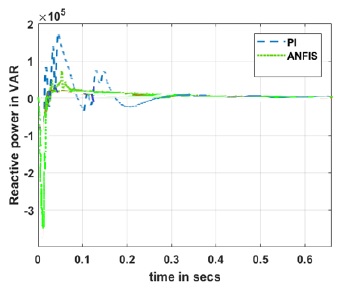Artificial Intelligence Approach for the Control of SPMSG Based Grid Connected WECS
DOI:
https://doi.org/10.54741/asejar.2.4.5Keywords:
decoupled direct & quadrature (dq) technique, incremental conductance (ic) algorithm, proportional integral pi) controller, six phase permanent magnet synchronous generator (spmsg)Abstract
In India, power plant requirement is rapidly increasing as non-conventional sources are in current need. Government financial aid plays important role for generator plant execution because of its tedious procedure. If the utilization of wind power production has to be doubled, then machines, turbines and converters are essential in two numbers. The research work includes parallel connection of two machines using star-delta-star transformer fashion resulting in six-phase permanent synchronous machine. This arrangement is more economical as the number of converters are reduced thereby increasing the efficiency by minimizing the switching losses. Initially rectifier setup is used wherein high frequency AC is converted to low frequency and maximum power point tracking is done with the aid of a converter. It is DC-DC conversion by decoupled DQ strategy. Later, it is again converted back to three phase AC so as to synchronize it to the grid. The system response is analysed by conventional PI controller by reducing the noise in the real & reactive power generation. Further, ANFIS-PI controller is implemented to improve the response of PI controller which is much essential for wind power generation. The MATLAB simulated results of PI controller system response and ANFIS-PI controller is presented in this paper.
Downloads
References
Leila Parsa. (2006).On advantages of multi-phase machines. IEEE, 6-10.
Emil Levi. (2008). Multiphase electric machines for variable-speed applications. IEEE Transactions on Industrial Electronics, 55(5), 1893 - 1909.
Marcelo Godoy Simones, & Petronio Vieira. (2002). A high-torque low-speed multiphase brushless machine—a perspective application for electric vehicles. IEEE Transactions on Industrial Electronics, 49(5), 1154-1164.
Suman Dwari, & eila Parsa. (2008). An optimal control technique for multiphase PM machines under open-circuit faults. IEEE Transactions on Industrial Electronics, 55(5), 1988-1995.
D Vizireanu, S Brisset, X Kestelyn, P Borchet, Y Milet, & D Laloy. (2007). Investigation on multi-star structures for large power direct-drive wind generator. Electric Power Components and Systems, 35(2), 135-152.
Sheng-Nian Yeh, Jonq-Chin Hwang, Ming-Chih Hsieh, & Li-Hsiu Chen. (2006). Development of wind power control system for six-phase permanent-magnet synchronous generators. Proceedings of 2006 World Wind Energy Conference, New Delhi, India.
R F Schiferl, & C M Ong. (1983). Six-phase synchronous machine with ac and dc stator connections, Part I: Equivalent circuit representation & steady-state analysis. IEEE Power Engineering Review, 3(8), 48-49.
S Sudhoff. (1993). Analysis and average-value modeling of dual line-commutated converter-6-phase synchronous machine systems. Conversion IEEE Transactions on Energy, 8(3), 411-417.
Nataraja C, & G S Sheshadri. (2021). A proposed methodology for intelligent control of six phase PMSG in a grid connected wind energy conversion system. International Journal for Research in Applied Science & Engineering Technology (IJRASET), 9(7).
Nataraja C, & G S Sheshadri. (2022). Grid connected pi controller of spmsg in wecs. SSAHE-Journal of Interdisciplinary Research, 2(2), 21-31.
Francisco P Demello, & Charles Concordia. (1969) Concepts of synchronous machine stability as affected by excitation control. IEEE Transactions on Power Apparatus System, 88(4), 316- 329.
Alizadeh M, Kojori S S, & Ganjefar S. (2013). A modular neural block to enhance power system stability. IEEE Transactions on Power Systems, 28(4), 4849-4856.
Mohsen Darabian, & Abolfazl Jalilvand. (2017). A power control strategy to improve power system stability in the presence of wind farms using FACTS devices and predictive control. International Journal of Electrical Power and Energy Systems, 85, 50-66.
Chun-Fei Hsu, Tsu- Tian Lee, & Kazuo Tanaka. (2015). Intelligent non-singular terminal sliding-mode control via perturbed fuzzy neural network. Engineering Applications of Artificial Intelligence, 45, 339–349.
Ravi Segal, Avdhesh Sharma, & M L Kothari. (2004). A self- tuning power system stabilizer based on artificial neural network. International Journal of Electrical Power and Energy Systems, 26(6), 423–430.
Soheil Ganjefar, & Mojtaba Alizadeh. (2013). A novel adaptive power system stabilizer design using the self-recurrent wavelet neural networks via adaptive learning rates. International Transactions on Electrical Energy Systems, 23(5), 601- 619.

Downloads
Published
How to Cite
Issue
Section
ARK
License
Copyright (c) 2023 Nataraja. C, Dr. G. S. Sheshadri, Dr. Shilpa G N

This work is licensed under a Creative Commons Attribution 4.0 International License.
Research Articles in 'Applied Science and Engineering Journal for Advanced Research' are Open Access articles published under the Creative Commons CC BY License Creative Commons Attribution 4.0 International License http://creativecommons.org/licenses/by/4.0/. This license allows you to share – copy and redistribute the material in any medium or format. Adapt – remix, transform, and build upon the material for any purpose, even commercially.










